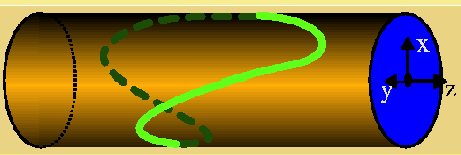
Examples of Path-Dependent Integrals: Vector Fields with Non-Vanishing Curl
Here is a vector function (xyz, xyz, xyz) for which the curl does not vanish anywhere, except the origin
![]()
![]()
These are the conditions that the curl is zero:
![]()
There is only one point where this occurs:
![]()
Let's evaluate the integral of the vector potential ( ![]() ) for any curve that wraps around a cylinder of radius R with an axis that coincides with the z-axis
) for any curve that wraps around a cylinder of radius R with an axis that coincides with the z-axis
Any curve that wraps around the cylinder can be parameritized as (x(t), y(t), z(t)) = (R cos(t), R sin(t), A ![]() (t)) where
(t)) where ![]() (t) =
(t) = ![]() (t + 2π) and in particular
(t + 2π) and in particular ![]() (0) =
(0) = ![]() (2π).
(2π).
Therefore d![]() = (-R sin(t), R cos(t),
= (-R sin(t), R cos(t), ![]() (t)) dt = (-y(t), x(t), A
(t)) dt = (-y(t), x(t), A ![]() (t)) dt
(t)) dt
The integrand for an integral of "VectorFunction" around such a curve is (written in terms of an arbitrary P(t):
![]()
The integral depends on the choice of P(t)
![]()
![]()
Let's introduce some specific periodic functions for P. Note how the value of the integral changes as the path changes:
![]()
![]()
![]()
![]()
![]()
However, here is curious result which shows that some special paths can ``accidentally'' have zero integrals : let P(t) = cos(n t),


![]()
![]()

Apparently, the symmetry of the vector function causes cancelation (note results for P = Sin and P=Cos, differ by a minus sign)
But, why doesn't n=1 give us the correct result above? Note that the denominator goes to zero as n→1
![]()
![]()
| Created by Wolfram Mathematica 6.0 (24 September 2007) |